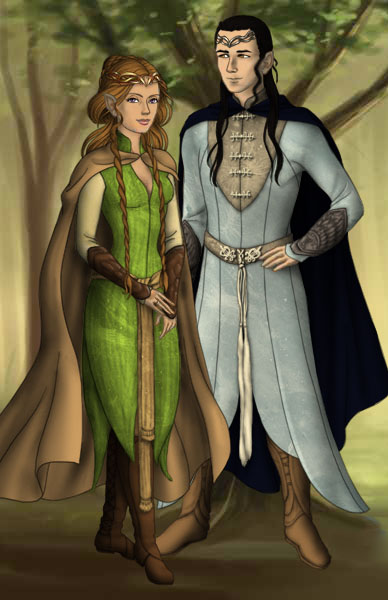Elf
Pointed ears and grand statures have come, over the years, to be the indicator of that noble and yet oft terrifying species of the magic-drenched elves...Elves are tall, lithe humanoids that settled upon the surface of Istralar following their evacuation via elf-gate of their former home and formed an immediate bond with the natural world that is often compared to the closeness of druidic tradition. Despite differences in regional tradition and disparities between ethnicities, this intrinsic respect and love for the natural world runs in the blood of almost every elf, and drives the elven tendency to reject others. This isolation isn't helped by their lengthy lifespans. Elves live for centuries longer than a human could ever hope to, and as such, the brief decades a human could offer them pale in comparison to the time they could spend forging deep bonds with their kin, or indeed, with their particular corner of the world. An elven druid who has remained in their own domain for centuries may know every falling leaf by the feel of it; a halfling could never achieve the same without magical aid. Arcane magic became a specialty of the elves when it first arrived upon Istralar; it led to their presence on Terra Arcana in higher numbers than almost any other species, and to their overwhelming association with magic. Galasthin is known as a pioneering centre of magical research and tradition across the borders of what is arcane or divine, and elves make up great numbers in every organisation related to magic - whether that be the Keepers of Divinity or the Kartovian Exploration Society.
Basic Information
Anatomy
Elves have tall, slender physiques that lean towards dexterity rather than strength. They remain similar in structure to humans, but their increased height and effortless grace comes at the cost of a weaker skeletal structure.
Genetics and Reproduction
To be blessed with motherhood is wondrous for any elf. Elves capable of bearing children undergo a fluctuating yearly menstrual cycle quite unlike a human's; the duration of their period can last anywhere from a week to three months. Their most fertile times are similarly in flux - a few months after a period, they enter a period of fertility that can last anywhere from three days to a month, signified largely by a slightly heightened temperature and occasional odd pains. Conception is achieved by sexual intercourse during this fertile period, but even during this time, the chance of conception is fairly low. Many elven couples are forced to wait multiple years to bear children unless magical aid is sought.
It generally takes eleven months for an elven child to gestate (though some may take longer) when the parent is pregnant. During this time, the childbearing parent must be defended as their natural reflexes will suffer. Birth is a difficult process, traditionally made easier through the aid of other elves and fey. Twins are nearly entirely unheard of, and usually result in severe damage during childbirth - sometimes resulting in the parent's death. Mostly due to their frail constitution, elves choose to only bear two or three children, as the risks dramatically increase after the third child. Parents with more than three children receive mixed responses; admiration for their bravery, but worry that their actions will encourage copycats.
Elven society is constantly in decline; numbers only maintain by the use of magical aids throughout the various elven countries.
Growth Rate & Stages
Elven children grow extremely fast in their early years, being able to speak and walk in their first year. Whilst physical maturity is not completed until their late 70s, and they are not considered fully mature until they reach the age of 110, their minds develop far more swiftly (though true maturity is only gained with experience). Young elves might appear to be human-style toddlers, but will possess mature language and skill beyond their apparent years.
Elven ears begin as slight points, and only become the long, pointed ears of tradition after physical maturity. This is often a point of teasing for younger elves. Occasionally, the ears will not develop properly and will require magical intervention.
Elves hit middle-age at around 175 years old, are considered 'old' at 263 years, and venerable at 350 years. The eldest of all elves can live to around 750 years, but old age can claim them any time after they hit 350.
Ecology and Habitats
Whilst elves are originally from another planet, they now find themselves most at home in forests, wildernesses and other areas of secluded nature. Most elves are in touch with their environment, and take pains to protect and defend it from any aggressors. Cave elves are extremely rare, and are often stigmatised in elven society due to their proximity to drow.
Additional Information
Perception and Sensory Capabilities
Elves bear a natural sense of magic that lingers in their blood. This magic is responsible for their classic ability to resist enchantments and sleep, and for the larger population of elven spellcasters. Depending on the heritage of any such elf, this magical ability may express itself in the form of elemental resistance, aptitude for particular forms of magic, or even the power to tap into dreams.
In addition, the stealthy nature of elves and their larger eyes and ears have allowed them to develop brilliant senses. In areas of dim light, they can see further than most men, and their sharp eyes can spot detail that others might miss.
Average Skin Colours
Average Eye Colours
Average Eye Colours
Genetic Descendants
Lifespan
550 years
Average Height
5 ft. 6 in. – 6 ft. 8 in. for males
5 ft. 6 in. – 6 ft. 4 in. for females
Average Weight
116 – 158 lbs. for males
96 – 126 lbs. for females
Related Ethnicities
Related Myths
Related Materials





Comments